Bergerac and the Dordogne
November 15th, 2017Cyrano de Bergerac

Statue of Cyrano de Bergerac
It is September 2017 and it is supposed to be hot and dry but I am on a river trip on the Dordogne and it is pouring with rain. We are in the historical market town of Bergerac in the region of the Dordogne in France. Finally after about two hours the rain stops and we are able to explore the town in dry if not warm weather. It is in the middle of a thriving wine area and attracts visitors from all over the world.
One of the reasons given for why wine growing prospered is the fact that Henry VIII agreed to no taxes being imposed on wine imported from this region to England. This may be true but it may also be because it tastes delicious. Anyway it is still very popular in the UK today. It is strange that the town is called Bergerac and is associated with the character Cyrano de Bergerac for it is rumoured he never lived here or visited the place. Perhaps today we may call this ‘fake news’. He is also the subject of a famous play of the same name by Edmond Rostand.
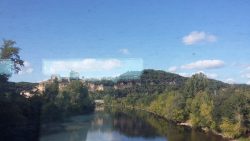
Banks of the Dordogne, Bergerac
Bergerac was founded in the 12th century and was the first place to have a bridge built over the River Dordogne. Originally it was a port and became a bustling centre of economic activity carrying goods, such as wood, sugar, coffee and salt, by boat from towns further away to the city of Bordeaux. The wood would be off loaded at Libourne near Bordeaux and used to make ships and wine barrels. The river traffic declined as soon as the railways were built in the late 18th century. It was actually conquered by the English in the Hundred Years’ War (1337-1453) but repossessed by the French 50 years later. It also became a major centre for Protestantism in the 16th century. Some might feel the town is being invaded by the British again today as many choose to live here or have a second home in the area. However the more recent British arrivals seem well integrated into French life and culture and are crucial to the economic prosperity of the town.
If you would like to stay with Airbnb in this part of France please click here
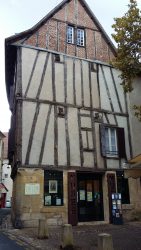
Musée du Tabac
The ‘French Resistance’
What might be less well known is the fact that Bergerac was a key centre for the ‘resistance movement’ in the Second World War. There is a plaque commemorating this above one of the cafes near the indoor market. Apparently this is where the ‘resistance workers’ use to secretly meet and radio their messages to London. This also leads to the ‘old town’ which is a delightful area of timber framed houses dating back many centuries. A market is also held here on a Wednesday and Saturday which attracts folk from all the surrounding area. It is a time to gossip as well as to buy fresh food enticingly displayed. Interestingly organic fruit and vegetables are now a major part of the produce for sale on the stalls. The stall holders allow you to taste the food before you buy and I purchase delicious mushroom flavoured sausages and tomatoes the size of tennis balls.
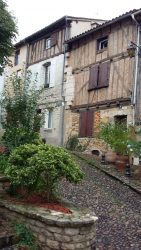
Old town Bergerac
My favourite place to visit is the tobacco museum (Musée du Tabac). Bergerac used to be a major tobacco growing area. Some may be discouraged from visiting because of the now known health hazards of smoking but don’t let this put you off. It doesn’t celebrate smoking but it does show brilliantly the historical context of tobacco and how it helped slaves cope with the degradation of their lives, plus the importance of smoking advertisements in the culture of the western world in the 1960s and 1970s featuring glamorous characters such as Omar Sharif. The film clips are amusing but somehow still resonate today. The paintings on show cover smoking through the centuries and feature pipe smoking in a way for us to understand how much it was once so much a part of so many people’s lives.
There are also a number of fascinating objects on display including a machine that made figureheads of famous people for the heads of pipes; my favourite is Princess Diana. Museums from around the world could learn from the imaginative and fun way the subject is explored. There is a stunning collection of pipes, cigar holders, tobacco jars, snuff boxes and tools of the trade from all round the world.
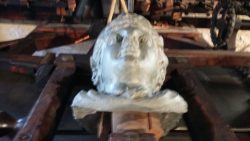
Princess Diana, pipe figurehead
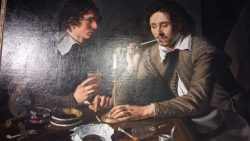
Picture tobacco museum, Bergerac
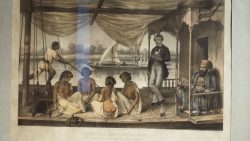
Picture tobacco museum, Bergerac
Trying to catch the train to Bordeaux
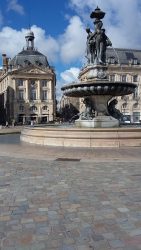
Historic centre Bordeaux
I am on the 8.15am train to Bordeaux and am grateful it has arrived at Bergerac station. All later trains have been cancelled and apparently this is currently happening everyday. The only alternative is a tortuous journey by bus which takes almost double the time. No reason is given for the cancellation; is it engineering works or a shortage of train drivers or perhaps they are trying to boost the number of bus passengers? Two days later we are travelling to Sarlat in the opposite direction and wait for 20 minutes on the train only to be told the train is cancelled and we are to ‘catch’ a bus outside the train station. We wait a further 20 minutes for a bus to arrive only to be told to get back on the train as it is now running. There is a high speed train from Bordeaux to Paris, which passes through Bergerac. This is brilliant and regularly runs on time. Not so the local trains.
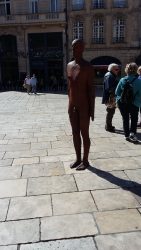
Statue Bordeaux
What will happen to you in the next 7 years?
The journey takes about one hour thirty minutes and passes through some fine wine growing countryside. I am looking forward to my visit to Bordeaux as about 7 years earlier I had stayed in the city for a few days and wanted to see what had changed. I had been organizing a conference at the University of Bordeaux 1. Since the event, the three universities Bordeaux 1, 2 and 3 have been merged.
I started to muse over what had happened to me in the intervening years. My father had died, I had retired from full-time work, my eldest daughter had moved to Portugal and I had worked on a two year project in the country of Georgia. Some of the ‘landmarks’ in my life I might have anticipated but none of them were a key part of my thoughts seven years ago. My Dad died at age 91 but somehow I was never able to picture his death despite him being this veritable age. I was approaching a time in my life when many people retired from work but I had no idea when I would retire or how I would spend my time. Working in Georgia came as a complete but delightful surprise. Can I guess what I will be doing in the next 7 years? Should you plan for this? Strangely travel can aid this process as it allows you to be more detached about your life and break away from many of your habits which can bind you to routines. This can be comforting but also a trap.
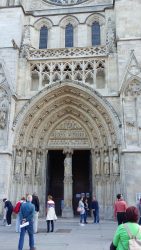
Bordeaux Cathedral
Bordeaux – a transport hub
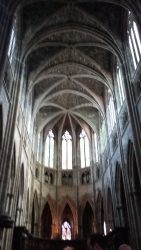
Bordeaux Cathedral
Bordeaux has a brilliant inter-connected transport system. You can buy a travel ticket which includes the bus, train and tram. ‘Cycles’ can be collected at your destination and then left somewhere else in the city for someone else to use. It feels like a modern European city but with world heritage eighteenth century buildings in the area of the ‘quartier St -Pierre’. It is not part of the Dordogne region but is situated by the side of the River Garonne and is the capital of the province of Aquitania Secunda. It can easily be explored on foot, if you are good at reading maps! We are standing in front of the Grand Théâtre but can we find our way to the Cathedral. After several aborted walks along side streets we eventually arrive at the Cathedral which is well worth a look inside. It is situated next door to the town hall.
I sat in a cafe opposite the cathedral and adjacent to the city hall and watched as hundreds of visitors entered the Cathedral and a sporadic number of people visited the city hall building. Strangely there was an armed policeman standing outside the city hall but no one to protect the cathedral entrance which attracted far more people. Are the inhabitants of the town hall (hotel de ville) of more value than the visitors to the cathedral or have the administrators of the cathedral requested no armed guards?
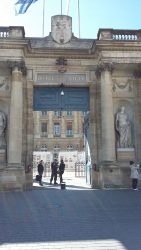
Town hall Bordeaux
On my previous visit I had attended a reception hosted by the city mayor and vividly remember the interior with beautiful and extravagant chandeliers adorning the ceiling. The welcome was warm and generous with French wine flowing and delicious food. The hosts were rightly proud of their city and its traditions.
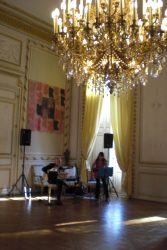
Inside Bordeaux town hall
There is a vibrant outdoor cafe scene, even in September, and local workers eat their food alongside tourists. The tradition of the French taking their time over their food still seems to be true. The French office workers are still eating their food and drinking well after an hour, whereas in London they would have been dashing back to their desk. The cost of eating out is not cheap, at about 40 euros for two people at lunchtime if you have two courses and a glass of wine. It is a little cheaper if you choose the set menu. The fall in sterling against the Euro is starting to have an impact. On display are modern sculptures of nude men which female tourists happily have their photographs taken alongside. In England we seem far more prudish and I cannot think of an equivalent in a UK city.

Sarlat
Day trip to Sarlat-le-Canéda
Bergerac is a good base for a week to explore the local area even if you have not the use of a car. The local train station can provide a link to interesting towns such as Sarlat and St Emilion. Both are only one hour’s train journey from Bergerac. However you need to be aware that the stations are usually based about 2 kms outside of the towns. Strangely there are no regular connecting buses or taxi service. So allow lots of time to walk your return journey to the station. Sarlat is very popular with tourists from all round the world including Americans, Australians, Chinese as well as Europeans. The classic Medieval buildings are the main attraction. The best way to explore the town is just to wander and walk down some of the side streets. However it does seem overwhelmed by tourists; even out of season it is very busy. To some extent it is a victim of its own success.
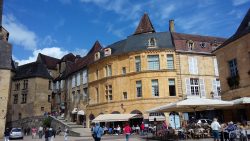
Sarlat
A timeless memorial
What I found most interesting is the war memorial near the centre of the town. If you examine the names below many of the surnames are repeated several times and probably coming from the same families. Most of the first or Christian names are still popular today such as Pierre, Louis, Jean, Paul, Yvonne and Henri. It is a reminder that the victims are both male and female and include a number of children. The impact on families will still be felt today. There will also be equivalent German families that will have suffered in World War II. It seems like a timeless memorial and even as you stand in front of the stone portraying the names you can feel the pain of war. Somehow by displaying the names of the dead it has a healing quality and is a timely reminder of how important it is to build ‘bridges’ between countries and nationalities.
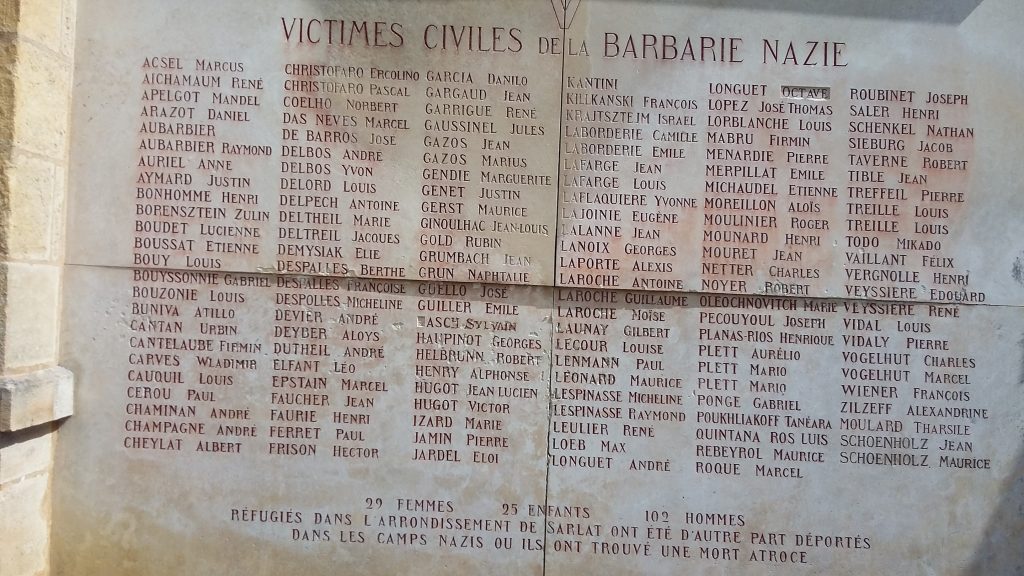
War Memorial Sarlat
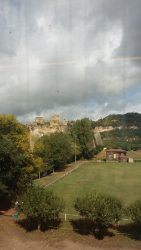
Manoir d’ Eyrignac
The River Dordogne
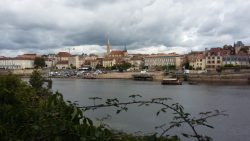
River Dordogne, Bergerac
The train line to Sarlat crosses over the River Dordogne several times. This is because the river meanders spectacularly backwards and forwards (these are sometimes called ‘cingles’) rather than going in a straight line. I am not quite sure why this is. Perhaps it is curving around the more hilly areas. The source of the River Dordogne are two tiny streams, the Dor and the Dogne, erupting as waterfalls on the slopes of the volcanic Puy de Sancy in the Auvergne, a region northeast of the Dordogne. It eventually meets the Dronne and Ilse rivers at the town of Libourne near to the city of Bordeaux. The river formed an important frontier in the Hundred Years’ War as the English and French built and then fought over the castles and fortified towns.
Just outside Sarlat is the Manoir d’ Eyrignac. This can be seen clearly from the window of the train. An hour before we are due to leave Sarlat we rang 6 taxi firms for a ride to the station and all refused or did not answer. Fortunately we had allowed enough time to walk up the hill!
Fellow travellers included a number of English tourists who were mainly retired or semi retired. An increasing number are deciding not to hire a car but navigate the local towns and countryside by public transport. Unfortunately the local bus service is very limited. It is surprising the local authorities do not invest in a regular service between the villages and towns during the summer period, which would boost tourism and the local economy. There is an assumption when you visit tourist information centres that you have use of a car. The French seem very dependent on their cars because of a poor public transport system. Other parts of France such as Provence do have a reasonable local bus service, or did have when I visited 15 or 20 years ago.
St Emilion wine at Lidl
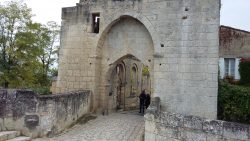
Medieval entrance to St Emilion
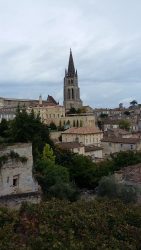
St Emilion
The village of St Emilion can easily be reached by train from either Bordeaux (35 km in distance) or Bergerac. It is famous for the wine grown in the area and even my local Lidl in Nottingham has bottles of St Emilion wine on its shelves. This might seem a little down market when you visit the place, as it mainly offers very expensive wines in the shops. The restaurants are also up market with only the finest wines on the menu. I suspect in winter the place is very quiet when the tourists have disappeared. We met a couple who had come over from Canada as part of an organized cycling tour and this was part of their itinerary. I admired their ‘fitness’ as the region is very hilly in parts and they were both in their late fifties.
St Emilion lived a hermit’s life in the eighth century and you can visit the cave which was his home beneath the Eglise Monolithe. Above this is the thirteenth-century Trinity chapel which was built in honour of St Emilion. Beneath the Belfry is a passage to the ‘catacombs’. The Chapel and the ‘catacombs’ are well worth a visit as there are many tombstones and hacked out images on the walls illustrating the passage of time over the centuries.
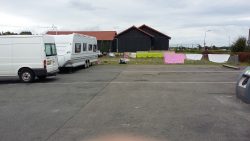
St Emilion station
We walked from the town, about 2 km, to the train station to catch the train to Bergerac. It was interesting to see travellers living in the car park by the station and hanging out their washing to dry. Some local caravan sites stay open over winter but are wary of travellers and gypsies taking over their site. This often means the gypsies regularly keep moving from place to place as they don’t have recognised sites to stay.
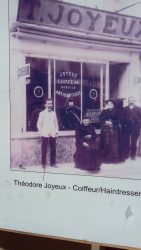
Original barber shop, Castillonnès
The man who founded the Tour de France
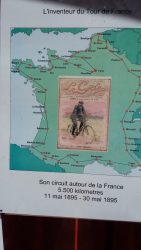
Map of the cycle circuit taken by Theodore Joyeux
Did you know that a Tour de France was completed by somebody in 1895? Theodore Joyeux, on a shaft drive bike (an alternative to the chain for transmitting pedal power to the wheel) cycled 5500 kms in 19 days doing a complete circuit of France. This record is official and undisputed but I suspect few people know about this. Theodore had a barber’s shop in the town of Castillonnès in the rural Lot-et-Garonne about 30km south of Bergerac. One day he decided, or so the story goes, to shut his shop, hop on his bike and cycle around France. I suspect in reality he may have planned the trip in advance. When I was visiting Castillonnès for the day I met an old man walking by the old barber’s shop and he said he used to go to Theodore’s barber’s shop as a young boy. I thought this was a lovely story in itself.
Castillonnès is a delightful town which is bustling with tourists in the summer but very quiet in the winter. There are now a few empty shops in the high street so no doubt some of the shop keepers are struggling to earn enough money in the summer to compensate for the winter when there is far less business. There is a thriving market here every Tuesday throughout the year. I met an English couple who had completely refurbished the local Manor House. This had been a labour of love over 15 years but the results are magnificent with attractive French antique furniture and all the rooms converted back to their original style and materials. There is also a movie house here which shows English and French films which reflects the number of British who have decided to make this place their home.

